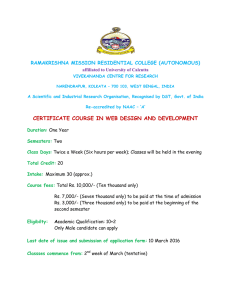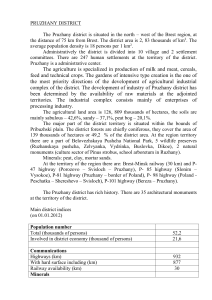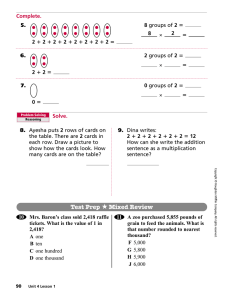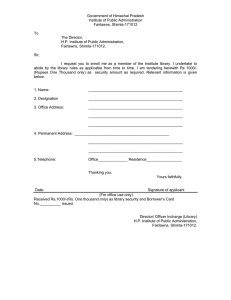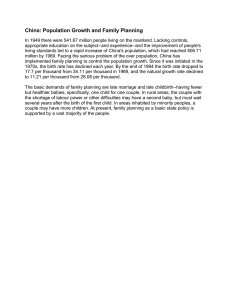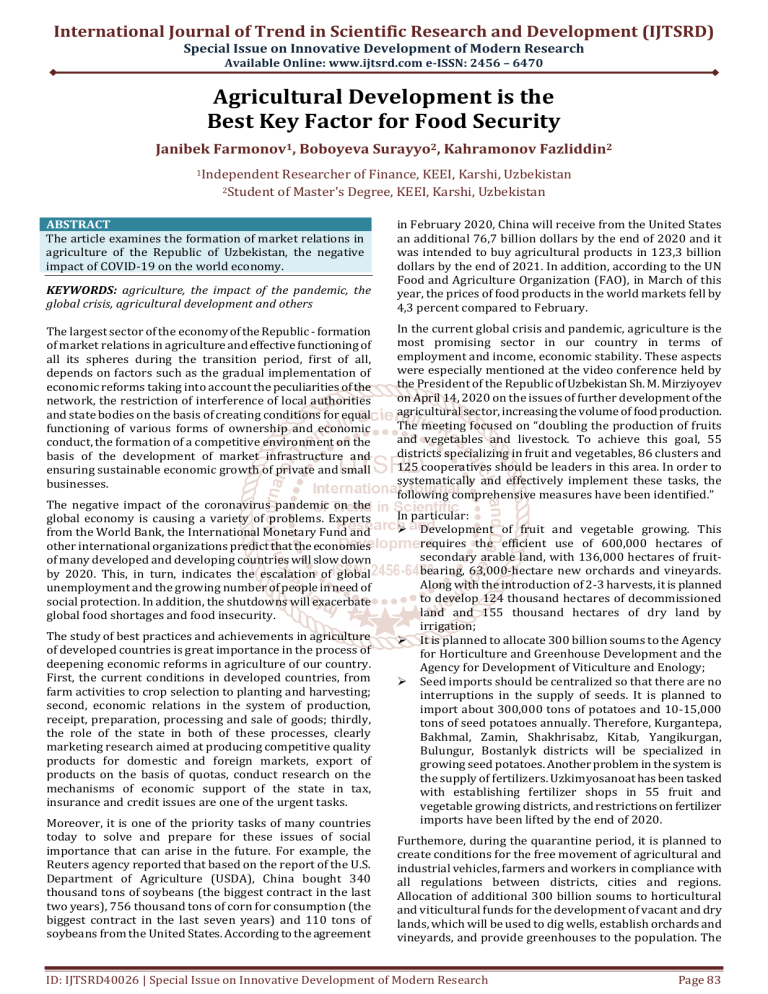
International Journal of Trend in Scientific Research and Development (IJTSRD) Special Issue on Innovative Development of Modern Research Available Online: www.ijtsrd.com e-ISSN: 2456 – 6470 Agricultural Development is the Best Key Factor for Food Security Janibek Farmonov1, Boboyeva Surayyo2, Kahramonov Fazliddin2 1Independent 2Student Researcher of Finance, KEEI, Karshi, Uzbekistan of Master's Degree, KEEI, Karshi, Uzbekistan ABSTRACT The article examines the formation of market relations in agriculture of the Republic of Uzbekistan, the negative impact of COVID-19 on the world economy. KEYWORDS: agriculture, the impact of the pandemic, the global crisis, agricultural development and others The largest sector of the economy of the Republic - formation of market relations in agriculture and effective functioning of all its spheres during the transition period, first of all, depends on factors such as the gradual implementation of economic reforms taking into account the peculiarities of the network, the restriction of interference of local authorities and state bodies on the basis of creating conditions for equal functioning of various forms of ownership and economic conduct, the formation of a competitive environment on the basis of the development of market infrastructure and ensuring sustainable economic growth of private and small businesses. The negative impact of the coronavirus pandemic on the global economy is causing a variety of problems. Experts from the World Bank, the International Monetary Fund and other international organizations predict that the economies of many developed and developing countries will slow down by 2020. This, in turn, indicates the escalation of global unemployment and the growing number of people in need of social protection. In addition, the shutdowns will exacerbate global food shortages and food insecurity. The study of best practices and achievements in agriculture of developed countries is great importance in the process of deepening economic reforms in agriculture of our country. First, the current conditions in developed countries, from farm activities to crop selection to planting and harvesting; second, economic relations in the system of production, receipt, preparation, processing and sale of goods; thirdly, the role of the state in both of these processes, clearly marketing research aimed at producing competitive quality products for domestic and foreign markets, export of products on the basis of quotas, conduct research on the mechanisms of economic support of the state in tax, insurance and credit issues are one of the urgent tasks. Moreover, it is one of the priority tasks of many countries today to solve and prepare for these issues of social importance that can arise in the future. For example, the Reuters agency reported that based on the report of the U.S. Department of Agriculture (USDA), China bought 340 thousand tons of soybeans (the biggest contract in the last two years), 756 thousand tons of corn for consumption (the biggest contract in the last seven years) and 110 tons of soybeans from the United States. According to the agreement in February 2020, China will receive from the United States an additional 76,7 billion dollars by the end of 2020 and it was intended to buy agricultural products in 123,3 billion dollars by the end of 2021. In addition, according to the UN Food and Agriculture Organization (FAO), in March of this year, the prices of food products in the world markets fell by 4,3 percent compared to February. In the current global crisis and pandemic, agriculture is the most promising sector in our country in terms of employment and income, economic stability. These aspects were especially mentioned at the video conference held by the President of the Republic of Uzbekistan Sh. M. Mirziyoyev on April 14, 2020 on the issues of further development of the agricultural sector, increasing the volume of food production. The meeting focused on “doubling the production of fruits and vegetables and livestock. To achieve this goal, 55 districts specializing in fruit and vegetables, 86 clusters and 125 cooperatives should be leaders in this area. In order to systematically and effectively implement these tasks, the following comprehensive measures have been identified.” In particular: Development of fruit and vegetable growing. This requires the efficient use of 600,000 hectares of secondary arable land, with 136,000 hectares of fruitbearing, 63,000-hectare new orchards and vineyards. Along with the introduction of 2-3 harvests, it is planned to develop 124 thousand hectares of decommissioned land and 155 thousand hectares of dry land by irrigation; It is planned to allocate 300 billion soums to the Agency for Horticulture and Greenhouse Development and the Agency for Development of Viticulture and Enology; Seed imports should be centralized so that there are no interruptions in the supply of seeds. It is planned to import about 300,000 tons of potatoes and 10-15,000 tons of seed potatoes annually. Therefore, Kurgantepa, Bakhmal, Zamin, Shakhrisabz, Kitab, Yangikurgan, Bulungur, Bostanlyk districts will be specialized in growing seed potatoes. Another problem in the system is the supply of fertilizers. Uzkimyosanoat has been tasked with establishing fertilizer shops in 55 fruit and vegetable growing districts, and restrictions on fertilizer imports have been lifted by the end of 2020. Furthemore, during the quarantine period, it is planned to create conditions for the free movement of agricultural and industrial vehicles, farmers and workers in compliance with all regulations between districts, cities and regions. Allocation of additional 300 billion soums to horticultural and viticultural funds for the development of vacant and dry lands, which will be used to dig wells, establish orchards and vineyards, and provide greenhouses to the population. The ID: IJTSRD40026 | Special Issue on Innovative Development of Modern Research Page 83 International Journal of Trend in Scientific Research and Development (IJTSRD) @ www.ijtsrd.com eISSN: 2456-6470 procedure for leasing for up to 7 years (with a grace period of 3 years), as well as the sale of the leased land for 5-10 years on the condition of growing certain types of food and directing the proceeds to the development of new lands is being introduced. It is planned to introduce a system of providing special financial resources for the cultivation and purchase of fruits and vegetables, as in the case of cotton and grain. Instead, commercial banks provide the clusters with the financial resources they need for working capital. They can also get short-term loans of 3 to 12 months, pledging the crop for cultivation and export. In addition, commercial banks will gradually allocate at least 2 trillion soums from their liquidity resources for working capital loans. In order to implement new projects in the field of fruits and vegetables and greenhouses, the task was to attract $ 700 million in credit lines from international financial institutions and direct the funds released by commercial banks from suspended projects to agriculture. There are also benefits for fruit and vegetable exporters. In particular, 50% of their transportation costs are covered by the Export Promotion Fund. An additional 50 billion soums will be allocated for this purpose. As known, the feed base is the main factor in the development of livestock. At least 70 industrial feed enterprises will be launched this year. With the introduction of water-saving technologies to provide them with raw materials, the full development of 38 thousand hectares of “lalmi” and “yaylov” lands is defined.In order to develop livestock and provide cattle, 74 family cooperative activities are launched in the Republic of Karakalpakstan, Bukhara, Jizzakh, Kashkadarya, Navai, Surkhandarya and Sirdarya regions. In each region, it is planned to organize farms intended for the preparation and sale of breeding cattle. It needs to say that poultry farming is one of the seven treasures, now on the basis of cooperative experience of feeding poultry to households is widely introduced. To do this, large poultry farms in the meat line will distribute from 100 head to 500 households 3-day chicks, deliver their food, provide veterinary services. Forty days later, the cooperative itself buys meat in a centralized way. In this way, each family will be provided with an additional source of income and an increase in the employment of the rural population. The Ministry of employment and labor relations carries out additional incentive payments from the Public Works Fund for the period of feeding poultry to families participating in the cooperation. working intensively in artificial basins will be established. Depending on the effectiveness of use, stratified rates of land tax are applied. In addition, in each region there are established exemplary districts specializing in fisheries, in which credit funds are allocated for the establishment of an intensive method of 10-15 fisheries (an average of 100 tons of fishing from 1 hectare), processing enterprises. Attention was paid also to the development of beekeepers, the importance of the distribution of more than 20 beekeepers slots to households by increasing the production volume by 5 times, the establishment of a beekeeping cluster enterprise in each district, the establishment of a cooperative system was emphasized. In this regard, recommendations were made on the full operation of forestry facilities, the maintenance of more than 16,5 thousand new bee nests. One of the reserves that provide the rural population with work at home is the silk industry. Considering that 382 thousand boxes of silk worm feed this year, this means that at least 750 thousand people are employed. Today, in the regions on the basis of the principle of “one household - one box of silk worm”, silk worm seeds are distributed, farmer farms, cotton and grain clusters are also widely involved in the feeding of silk worm. For the further development of the system, 145 billion soums of credit lines of commercial banks will be opened. Payment of additional incentive payments from the account of the fund of Public Works to the apartments, which received the specified harvest, was determined. The implementation of these measures aimed at the development of agriculture creates the opportunity to meet the demand of our country for food products and to expand exports. It serves to provide employment for low-income citizens and temporarily unemployed citizens and to increase the source of additional income. This, in turn, will be an important factor not only to provide the population with stable food products, but also to reduce their prices. References: [1] Speech of the president of the Republic of Uzbekistan “at the Republican video conference dedicated to the field of agriculture with the most opportunities for ensuring employment and income of the population in our country, maintaining economic stability in the conditions of the current global crisis and pandemic”. // 14.04.2020 year. [2] Farmonov T. X. Prospects for the development of farmer farms-T.: “New century generation”, 2004. – 47 p. In the current year, the system of raising fish production to at least 350 thousand tons, granting subsidies to those ID: IJTSRD40026 | Special Issue on Innovative Development of Modern Research Page 84
